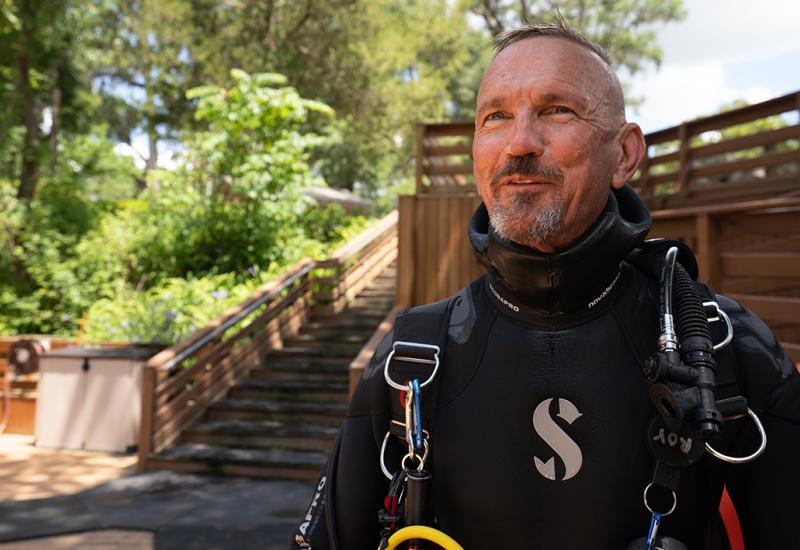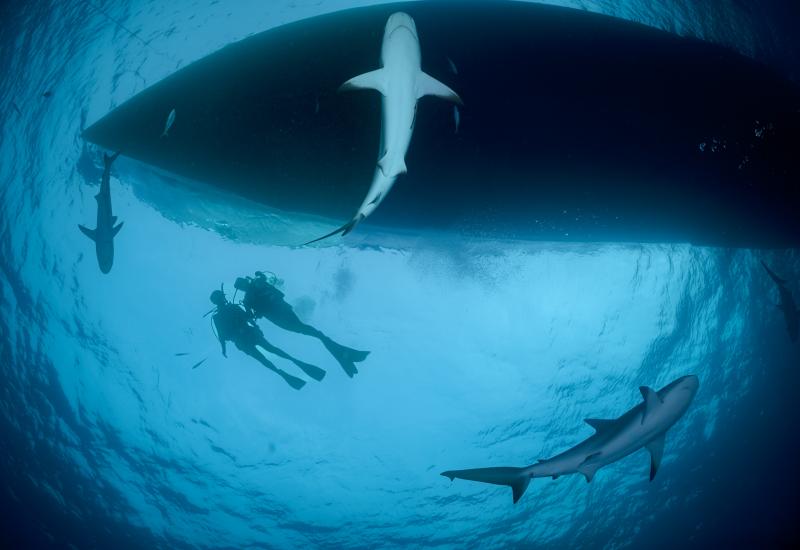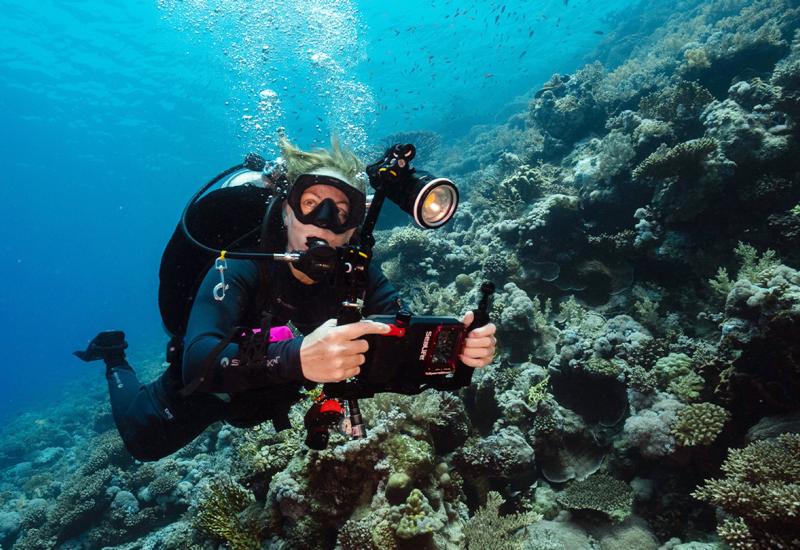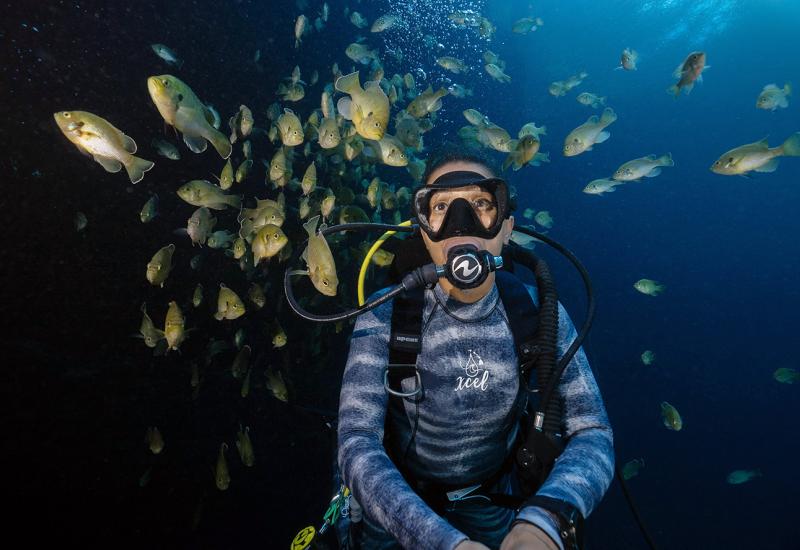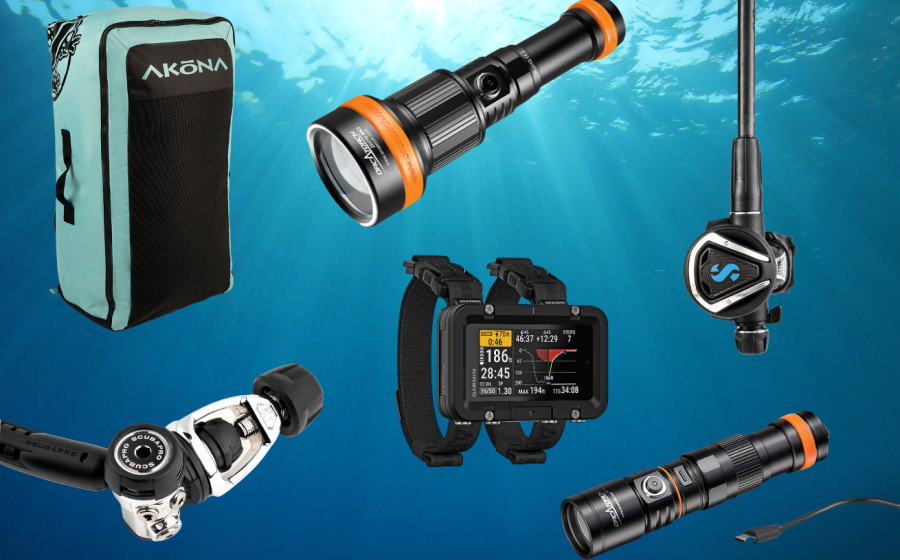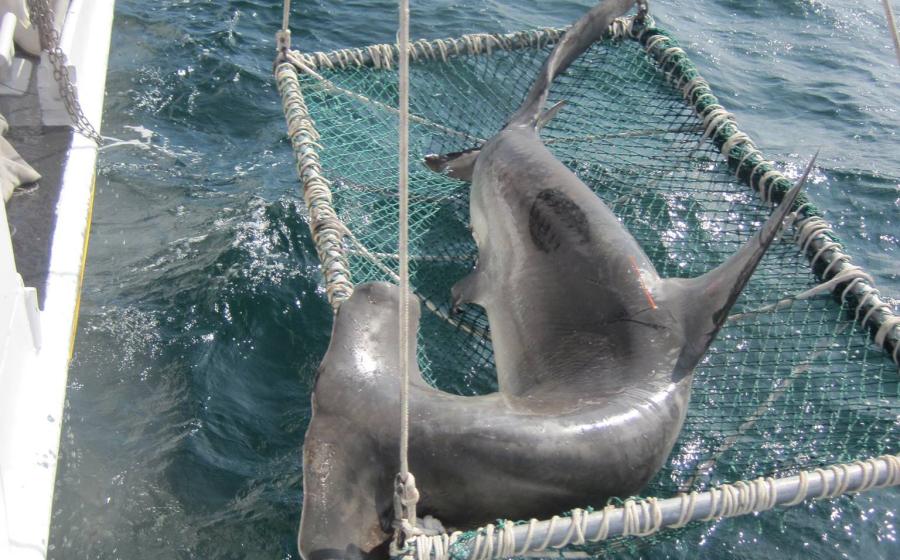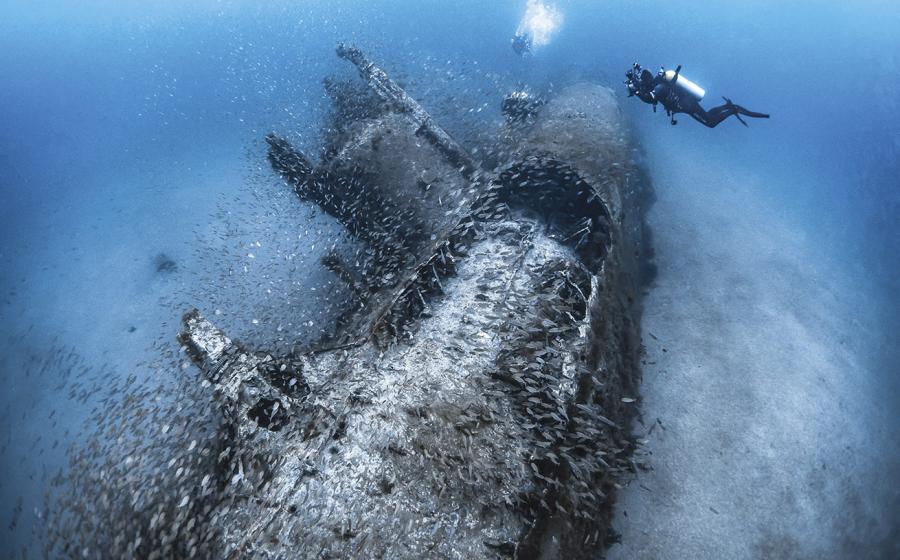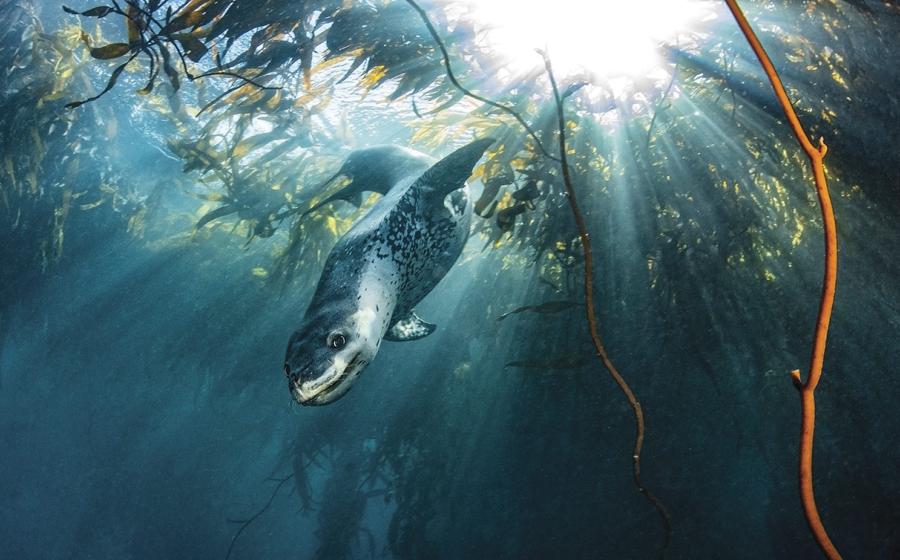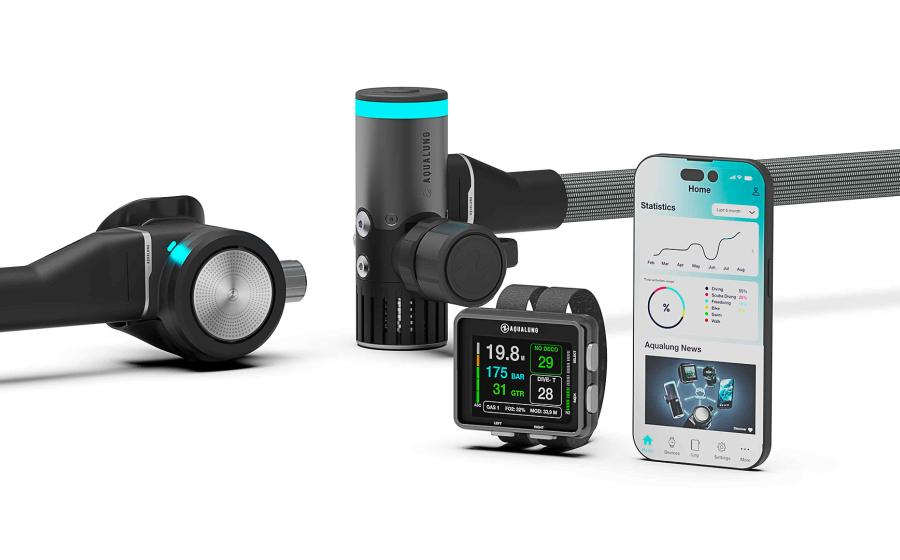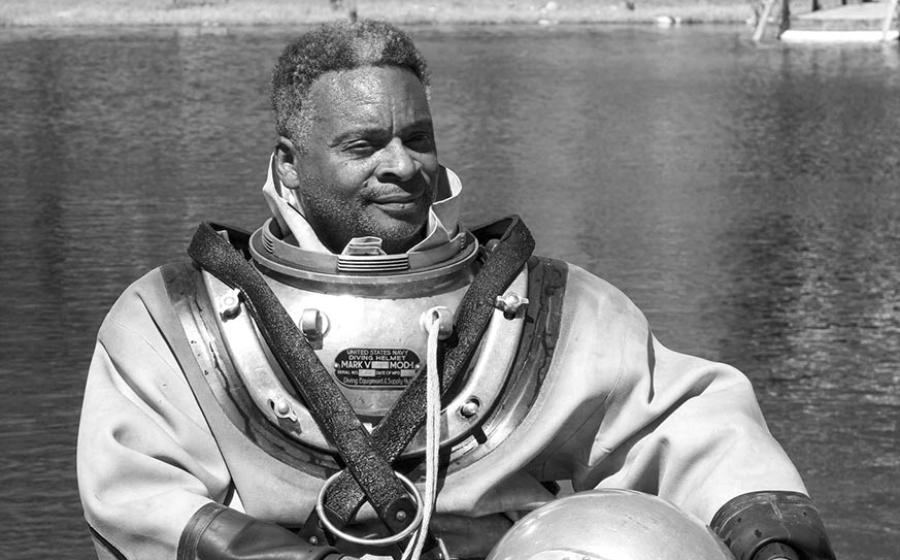Best Scuba Diving Fins: ScubaLab Gear Review
Our 2015 test evaluated 13 new or redesigned scuba fins — 10 open-heels and three full-foots — to find out how they measured up in terms of features, in-water performance and price. Find out which dive fins secured the top spots for best buy and testers' choice.
---
How We Test
Divers rated each fin from 5 (excellent) to 1 (poor) in the following categories:
- EASE OF DONNING FIN - In and out of the water, how easy the scuba fins are to put on.
- ADJUSTING FOR FIT - The effectiveness and ease of use of the buckles and straps.
- FIT AND COMFORT - The overall comfort and security of the fin on the foot.
- STABILITY - Whether the scuba fins have a tendency to wobble, slice side to side or strike each other during the kick cycle.
- POWER VS. STRESS - The perception of power produced during the kick cycle relative to the amount of effort put into the kick.
- KICKING STYLE - While swimming underwater, the ease and efficiency of the fin when using a flutter kick, frogkick and dolphin kick.
- ACCELERATION - While swimming underwater, whether the dive fins allowed testers to quickly increase speed.
- MANEUVERABILITY - The ease of getting and out of tight places — such as backing up, spinning or reversing directions — using fin movements.
- SURFACE SWIMMING - The efficiency of the fin while swimming on the surface or snorkeling.
- EASE OF REMOVING FIN - Efficiency of the straps, buckles, finger tabs, etc., in removing the fin.
Fins were also evaluated for weight, buoyancy and the effectiveness of non-slip material on the bottom of the sole.
---
Barefoot Comfort
No matter how great its design, you won’t really like your non-adjustable full-foot fins unless the fit is nearly perfect. So take the time to try on every available size to find one that’s just right for you.
---
Old is the New New
Nearly half of the fins we tested this year have strong design or material elements of classic fins — some going back decades. Our testing suggested that most divers are more concerned about performance (and some of those classic designsand materials per- formed very well) than whether a fin is old-fashioned or “funny” looking. In any case, as one diver noted, when they’re on your own feet, you don’t really see what they look like anyway.
---
What Kind of Fin?
There used to be scuba fins that we described as “full-foot” that slipped onto your bare feet with a stretch fit and had no adjustment, and fins we called “open-heel” that went over dive boots and had adjustable straps. You’ll notice our test crop this year included a pair of adjustable fins for bare feet, while half of the open-heel fins we tested had nonadjustable spring or bungee straps. While these newfangled design elements complicated our open-heel and full-foot category groupings, we view the new designs as a good thing — the in-water result has been less fuss and better comfort.
---
Vents and Channels
Two ways engineers boost efficiency in fins are with angled vents, something like louvers, and with channels of soft material in the blade to trap scoops of water — both designed to redirect water for increased thrust.
---
Q: What makes a fin a favorite?
A: Fin tests are subjective simply be- cause divers have such a broad range of swimming styles and physical characteristics. So it’s no surprise that divers have very different ideas about what constitutes an “ideal” fin. Still, comparing divers’ test scores to the fins they chose as favorites revealed what they valued most: power versus stress (more effort equals more thrust); fit and comfort; and stability.— Roger Roy, ScubaLab Director
---
Splitsville for Splits
A few years ago manufacturers were rushing to meet the demand for split fins, but it seems the trend has peaked; we haven’t had a new split fin submitted for ScubaLab testing since 2012. On the other hand, we still see plenty of splits when we’re diving — and know divers who swear by theirs — and many manufacturers still offer them in their lineups.
---
How to Care for Your Fins
Now that you’ve found your sole-mates, keep them in tip-top condition with these tips.
-
STASH THEM OUT OF THE SUN when they’re not being used. Exposure to heat and sunlight can cause premature cracking and discoloration, and can also weaken the bonds between composite materials.
-
KEEP BLADES , buckle assemblies and straps clean.
-
ALWAYS STORE FINS FLAT, otherwise you could end up with a permanent bend or crease in the blade, which could hinder its in-water performance.
-
NEW FINS USUALLY COME WITH FOOT-POCKET INSERTS — make sure you don’t throw them away. Storing your fins with the inserts in place will help maintain the shape of the fin’s foot pocket when you’re not diving — kind of like using a shoe tree for your street shoes.
---
No Two Blades Alike
A glance at these fins shows the diversity of designs from engineers all trying to solve the same problem: how to efficiently convert the back-and- forth motion of our legs into forward thrust in the water.
---
Looking for more ScubaLab testing? Check out more of our gear reviews:
- SCUBALAB 2015: Dive Knife Review
- SCUBALAB 2015: Travel Gear Review
- SCUBALAB 2014: Gear of the Year
- SCUBALAB 2014: Dive Bag Review
- SCUBALAB 2014: Regulator Review
- SCUBALAB 2014: BC Review
- SCUBALAB 2014: Dive Lights Review
- SCUBALAB 2014: Wetsuit Review
- SCUBALAB 2013: Fins Review
- SCUBALAB 2013: Mask Review
- SCUBALAB 2013: Regulator Review
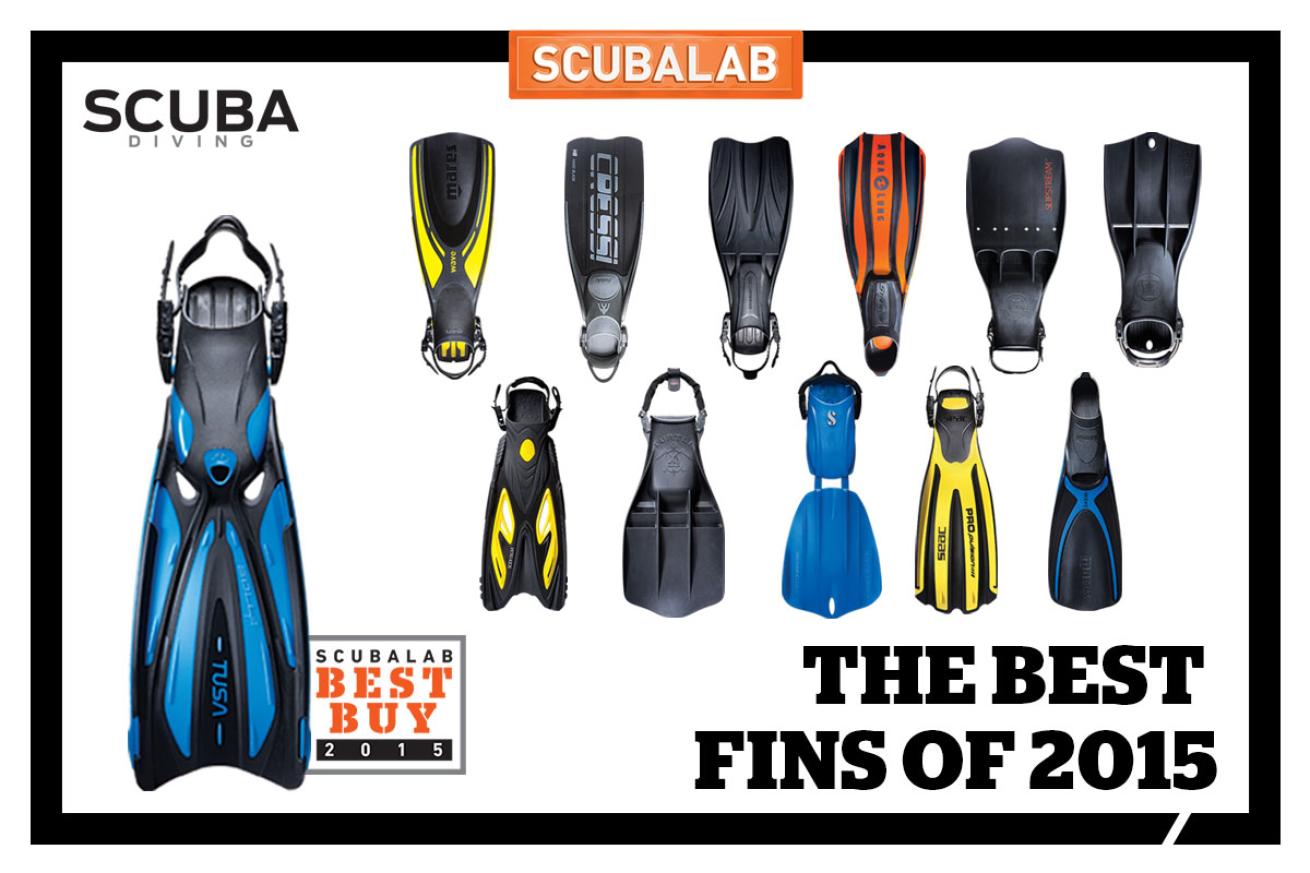
Zach Stovall2015 Head-to-Head Testing
Tested on performance, acceleration, stability and a host of other attributes, we present the best new and redesigned scuba fins on the market.
Our 2015 test evaluated 13 new or redesigned scuba fins — 10 open-heels and three full-foots — to find out how they measured up in terms of features, in-water performance and price. Find out which dive fins secured the top spots for best buy and testers' choice.
How We Test
Divers rated each fin from 5 (excellent) to 1 (poor) in the following categories:
- EASE OF DONNING FIN - In and out of the water, how easy the scuba fins are to put on.
- ADJUSTING FOR FIT - The effectiveness and ease of use of the buckles and straps.
- FIT AND COMFORT - The overall comfort and security of the fin on the foot.
- STABILITY - Whether the scuba fins have a tendency to wobble, slice side to side or strike each other during the kick cycle.
- POWER VS. STRESS - The perception of power produced during the kick cycle relative to the amount of effort put into the kick.
- KICKING STYLE - While swimming underwater, the ease and efficiency of the fin when using a flutter kick, frog kick and dolphin kick.
- ACCELERATION - While swimming underwater, whether the dive fins allowed testers to quickly increase speed.
- MANEUVERABILITY - The ease of getting and out of tight places — such as backing up, spinning or reversing directions — using fin movements.
- SURFACE SWIMMING - The efficiency of the fin while swimming on the surface or snorkeling.
- EASE OF REMOVING FIN - Efficiency of the straps, buckles, finger tabs, etc., in removing the fin.
Fins were also evaluated for weight, buoyancy and the effectiveness of non-slip material on the bottom of the sole.
Aqua Lung Stratos 3
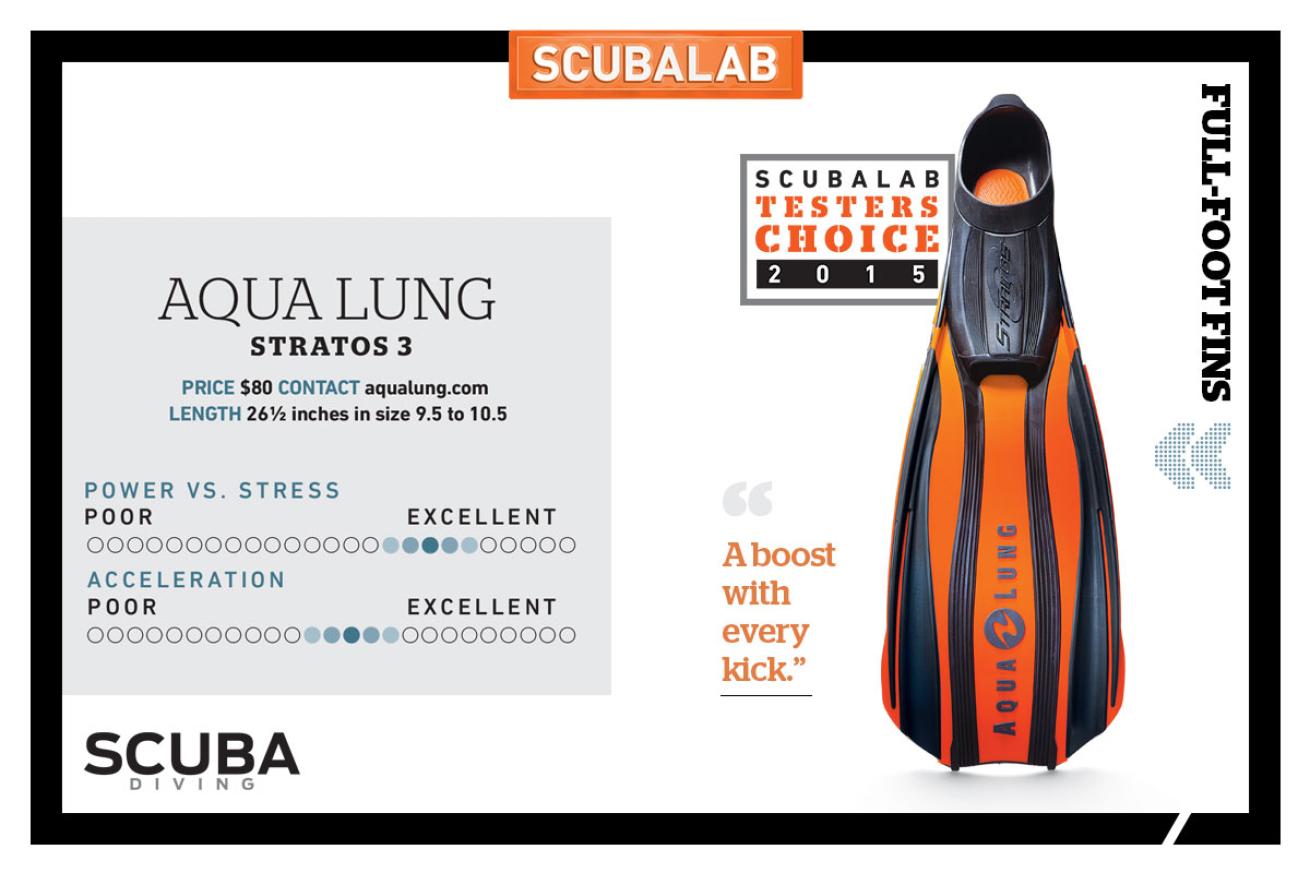
Zach StovallThe Aqua Lung Stratos 3 fin is comfortable and provides a lot of kick without tiring you out. It was our Testers Choice for full-foot fins.
The Stratos 3 has beefy side rails that pivot near the front of the foot pocket to get the whole blade into the action. Test divers found it an effective design, rating it very good for power versus stress, and for efficiency in the flutter kick. The six available sizes were able to comfortably fit almost all of our test divers. The toe opening is roomy and well shaped, and surrounded by soft material. The finger grip on the heel is small but soft enough to grip firmly. The Stratos 3 fin made it onto multiple divers’ top-three favorites list, and is our Testers Choice for this category.
Price: $80 | Contact: aqualung.com
Body Glove Vapor
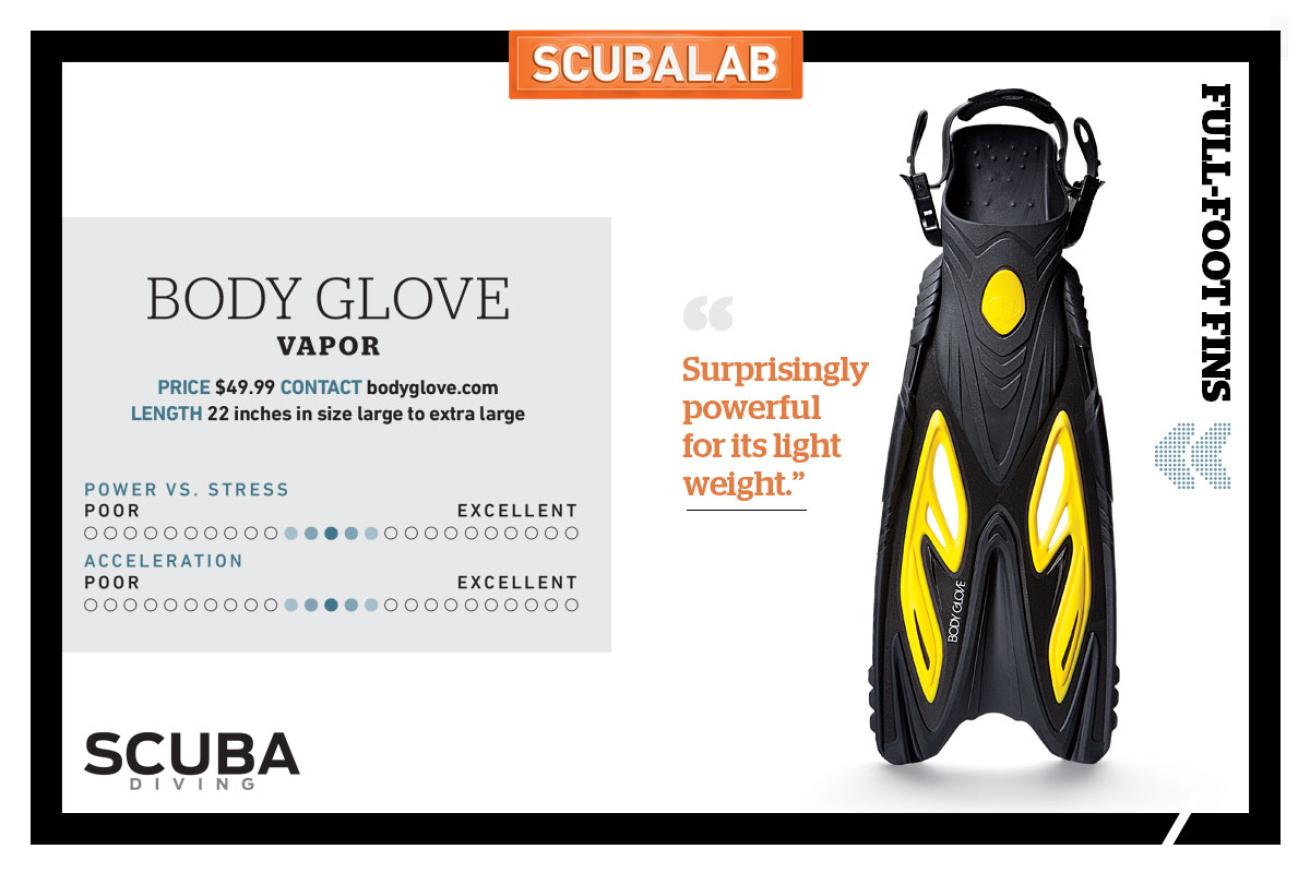
Zach StovallThis adjustable fin is meant to be worn on bare feet. The Vapor's compact size, effective blade and attractive price make it a good fin choice for traveling.
The Vapor is adjustable but worn on bare feet, and that combined with its compact size prompted more than one test diver to ask if it was a “snorkel fin.” They didn’t mean it as a compliment. But in the water, the Vapor proved quite effective. The Vapor tied the top score for maneuverability, and racked up good scores for power versus stress, for surface swimming, and for all kicking styles except frog kick, where divers rated it just fair. It also made its way onto more than one diver’s top-three list. What hurt the Vapor was its two sizes: one for 4.5 to 8.5 and one for 9 to 13, which didn’t fit all our divers. But if the fin fits, the Vapor’s compact size, effective blade and attractive price make it a travel companion to consider.
Price: $49.99 | Contact: bodyglove.com
Mares Wave
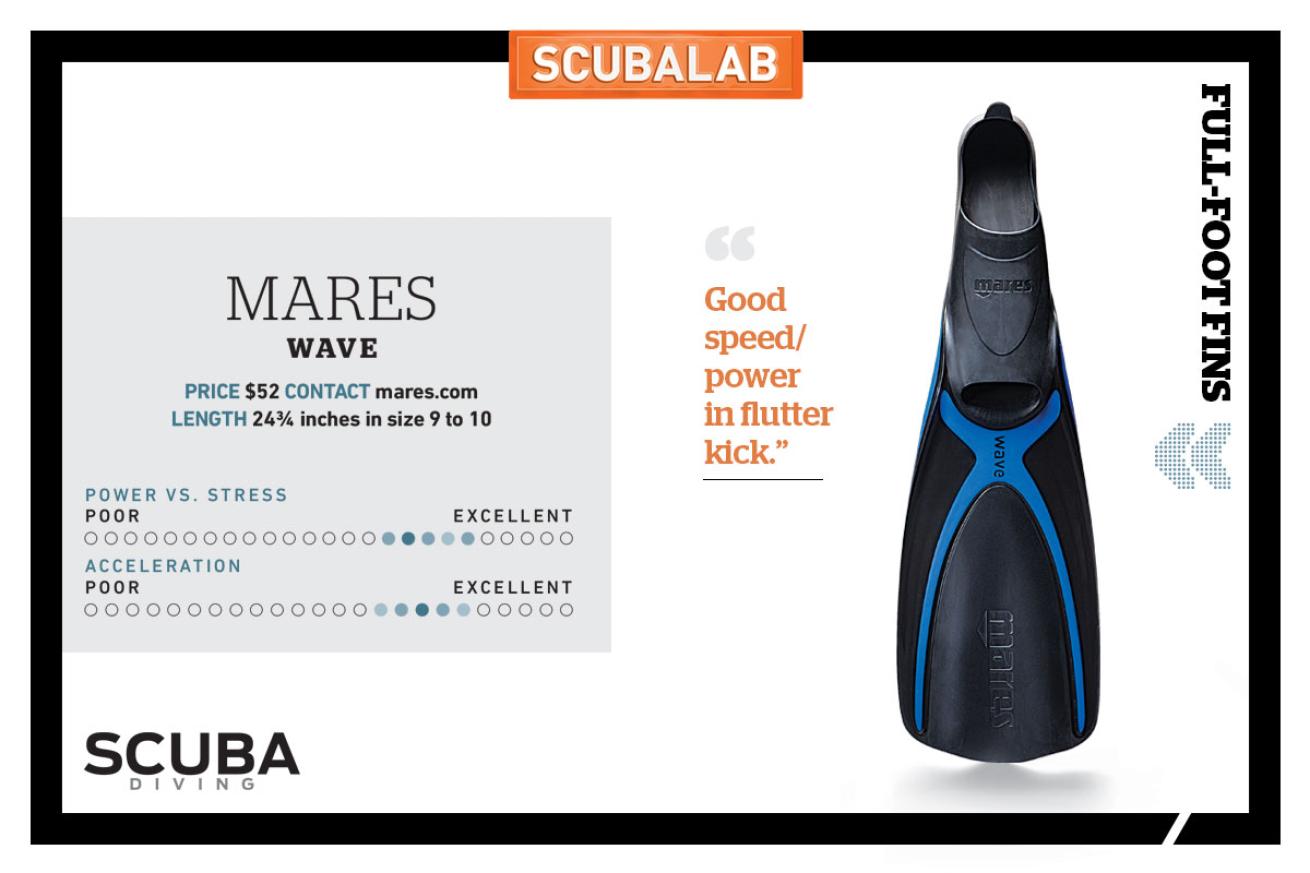
Zach StovallMares Wave was the lightest fin in our test, but still tied for high scores for power, acceleration and efficiency.
The full-foot version of the Wave has a distinctive large, soft-rubber pocket nearly as wide as the blade, suspended between ribs of stiffer thermoplastic material that extend to the side rails. The lightest fin in our test, the Wave weighed just 1 pound 6 ounces in size 9 to 10. Test divers found it stable and efficient. It tied the high scores for power versus stress, acceleration, and efficiency in the flutter kick, and was rated good in all other kicking styles and for maneuverability. With six sizes, it fit our test divers as well as any full-foot fin, which is to say some wished it was a little wider, or narrower, etc. A competent, comfortable fin for warm water, the Wave is also very attractively priced.
Price: $52 | Contact: mares.com
Apeks RK3
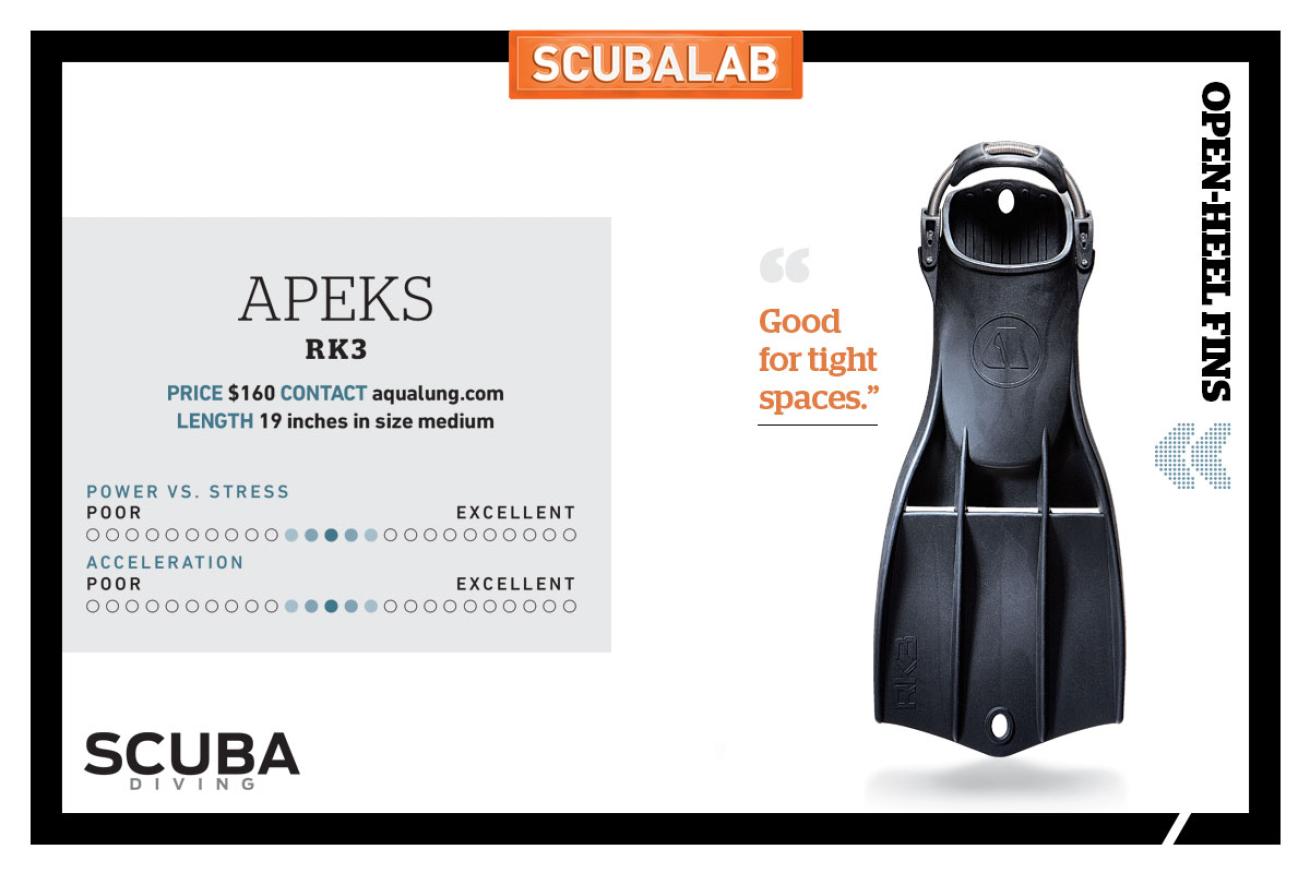
Zach StovallThe RK3 is an all-rubber fin from Apeks. The fin is incredibly maneuverable and able to make tight turns with ease.
The RK3 is the latest iteration of the venerable Rocket fin that has been around since, well, before we can remember. The RK3 has the familiar all-rubber construction and vented blades, but now comes with a stainless spring strap that test divers really liked, winning very good scores for fit and comfort, and for ease of donning. Not surprisingly, given the RK3’s modest dimensions, divers praised its ability to spin on a dime. It also racked up very good scores for efficiency in a flutter kick. It earned good scores for acceleration, but some divers noted that, for them, the fin’s best performance came from a moderate level of effort, with the payoff dropping when they kicked in the afterburners.
Price: $160 | Contact: aqualung.com
Cressi ARA EBS Hard Blade
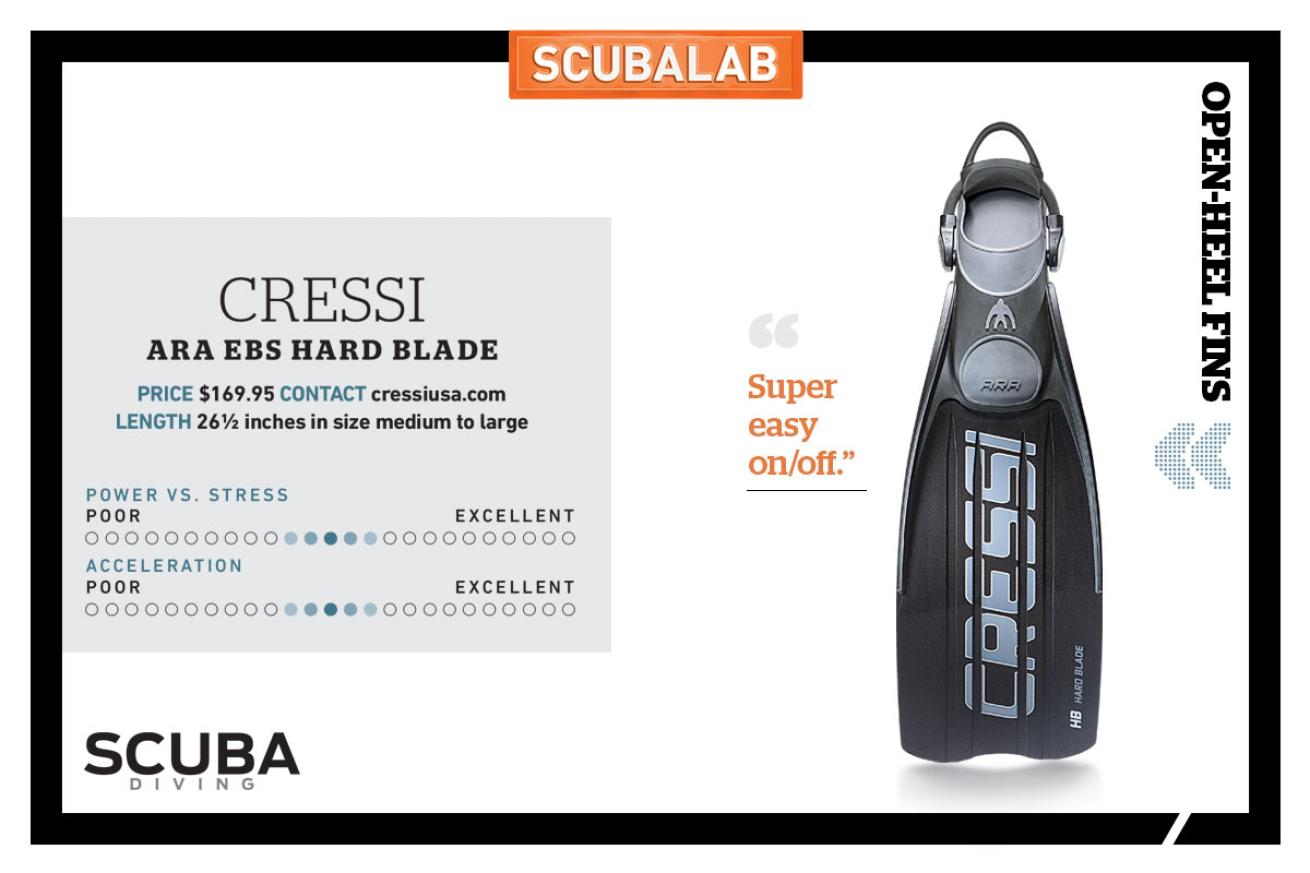
Zach StovallCressi's ARA EBS Hard Blade fin was designed with cold-water diving in mind. Even so, this scuba fin held it's own among other paddle fins.
Geared toward cold-water divers, the ARA has roomier foot pockets to fit drysuit boots. We were only able to get the new ARA in one size, so we don’t know how different the sizing actually is. But results from test divers who could wear the ARA suggest its appeal goes beyond just cold water; it tied for top overall score among conventional paddle fins. The EBS (“elastic bungee system”) is now standard on several Cressi fins (and can be retrofitted to others). The EBS was a hit with test divers, who rated the ARA very good for fit and comfort and for ease of donning and removing. The Hard Blade option we tried (there’s also a Soft Blade) was rated very good for flutter kick and good for other styles.
Price: $169.95 | Contact: cressiusa.com
Dive Rite XT
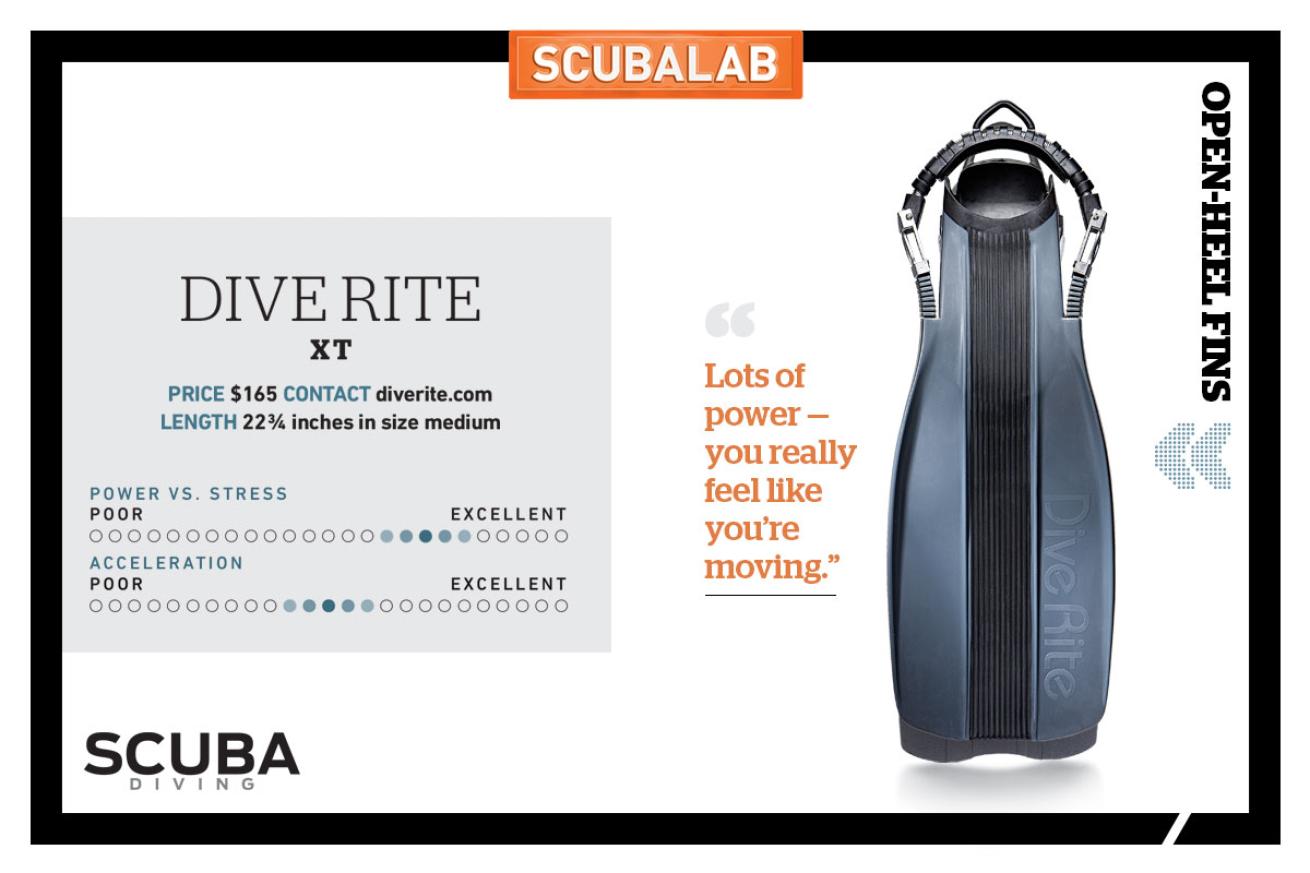
Zach StovallThis fin was well-received by scuba divers who prefer a stiff blade. Dive Rite's XT delivers stability and power in a comfortable open-heel fin.
The XT is another fin that had us asking, “Have we met before?” And with good reason, because while the XT has a new (and very good) stainless buckle system, it retains a familiar shape and the monoprene blend used for more than 20 years. That blend makes the XT firm but with a lively action that provides plenty of drive. The XT tied the high score for power versus stress, and got the highest score for efficiency in the frog kick. It also tied for high score for stability, thanks to that new spring strap. Some found the XT a little too firm for their kicking styles. But divers who dig stiffer fins with some oomph loved the XT, and no fin earned more votes on divers’ lists of their top-three favorites.
Price: $165 | Contact: diverite.com
Mares Wave
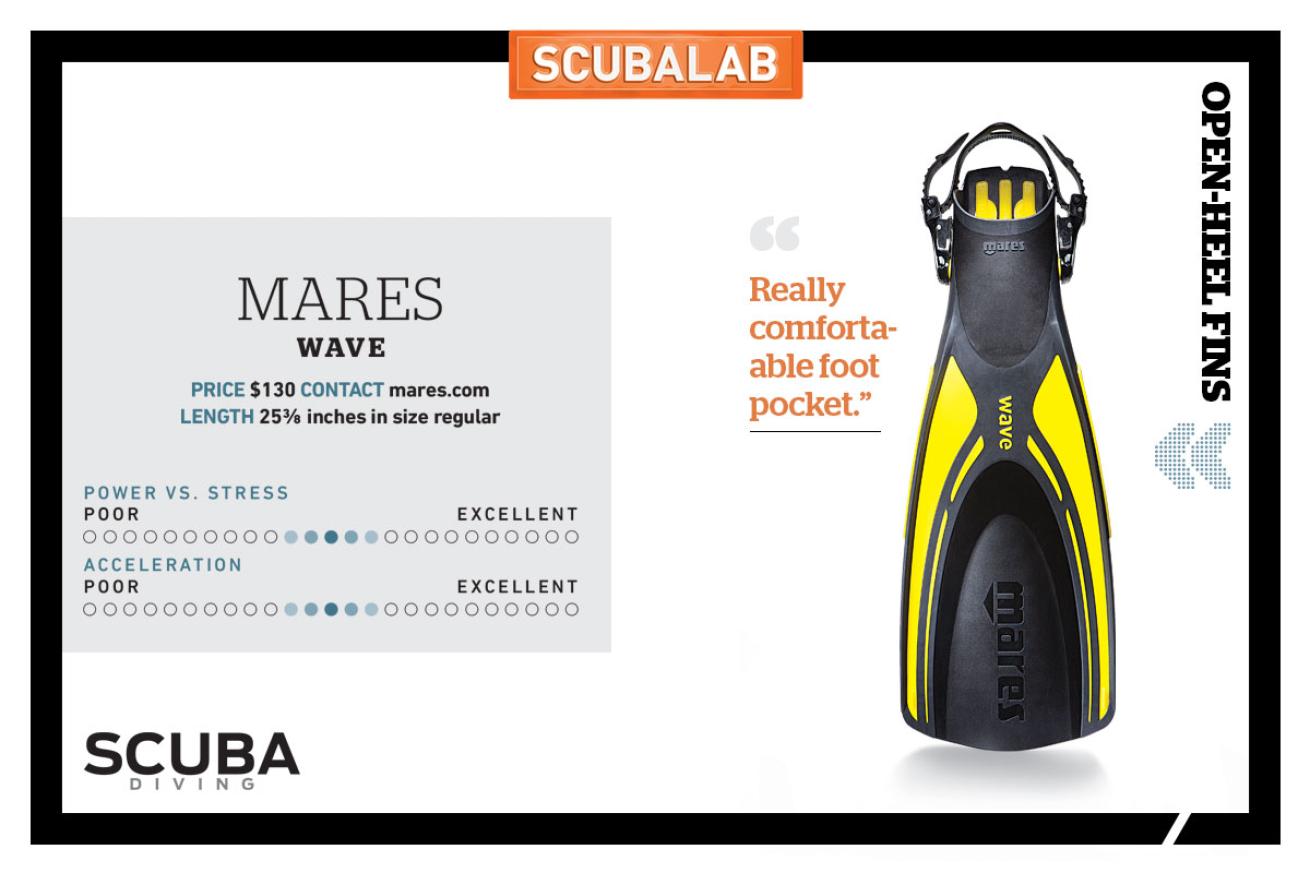
Zach StovallThe Wave is a stable, comfortable open-heel fin that provides plenty of flex.
If you want 10 opinions, just ask 10 divers. The Wave finished with an overall good score, but individual divers differed more than the final scores suggest. The Wave has a comfortable foot pocket and a blade that forms a large channel. Divers who scored the Wave highest noted its comfort and easy performance in any kicking style. Divers who scored it lower thought it was too soft, without enough muscle in the blade. Divers were also split on the buckles, which open to create slack for donning or doffing; some found them fussy, while others thought they were terrific. What divers did agree on was that the Wave is a stable, comfortable fin for those who like plenty of flex in the blade.
Price: $130 | Contact: mares.com
OMS Slipstream
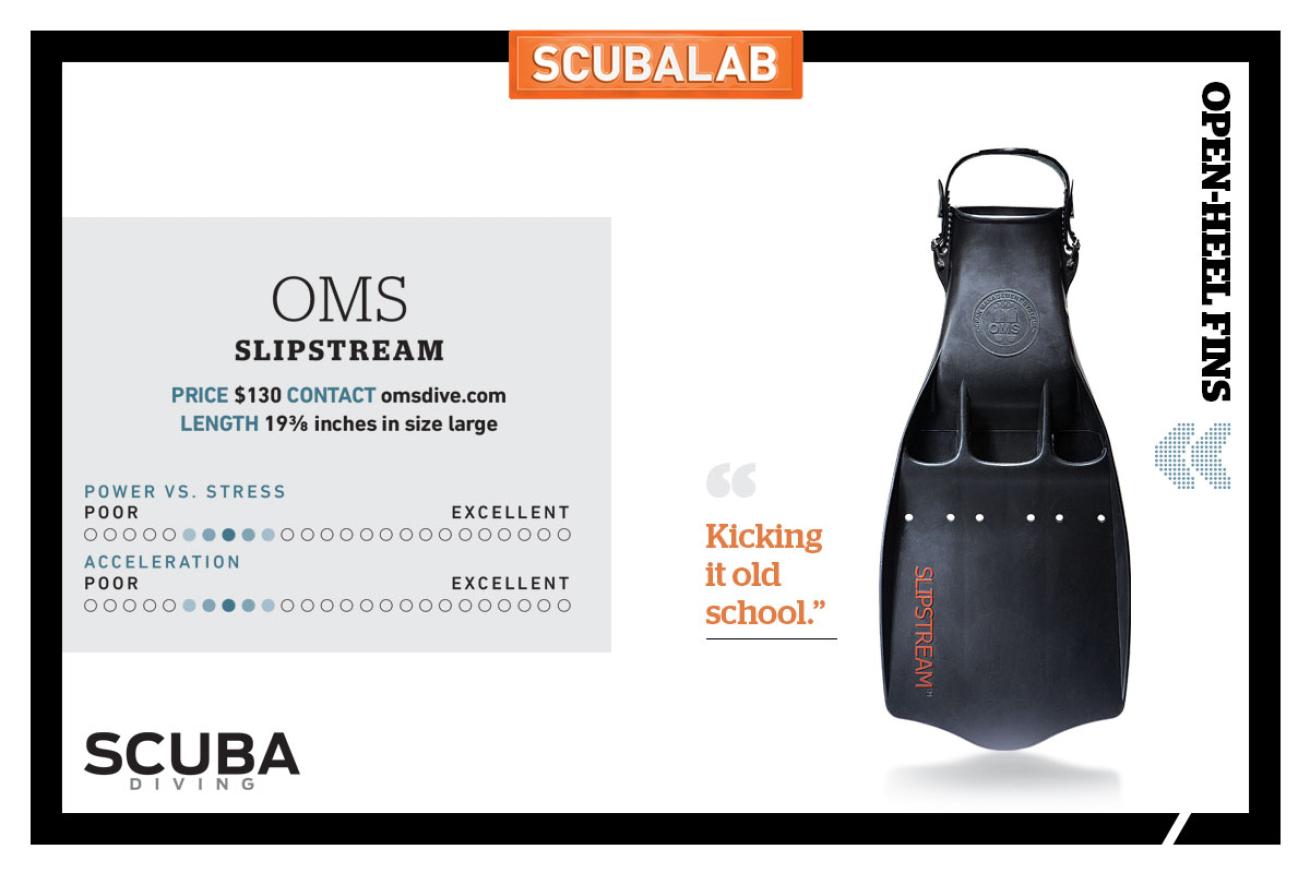
Zach StovallThe SlipStream's compact dimensions and light weight helped this OMS fin earn good scores for maneuverability, surface kicking and frog kicking.
The SlipStream’s classic design goes back decades. New models are being fitted with spring straps, but our test fins still had the old adjusters. That was too bad, because test divers didn’t care for the old-school straps, which are secure but fussy. A lighter-weight monoprene helps keep the SlipStream out of the silt, but the material is also less supple. Divers with thinner boots didn’t like the effect of that stiffness on the short foot pocket because it allowed the edge of the pocket to lever on the arch of the foot. Its compact dimensions and light weight helped the fin earn good scores for maneuverability, surface kicking and frog kicking, but the obsolete adjusters hurt its overall scores.
Price: $130 | Contact: omsdive.com
SEAC Propulsion Wave
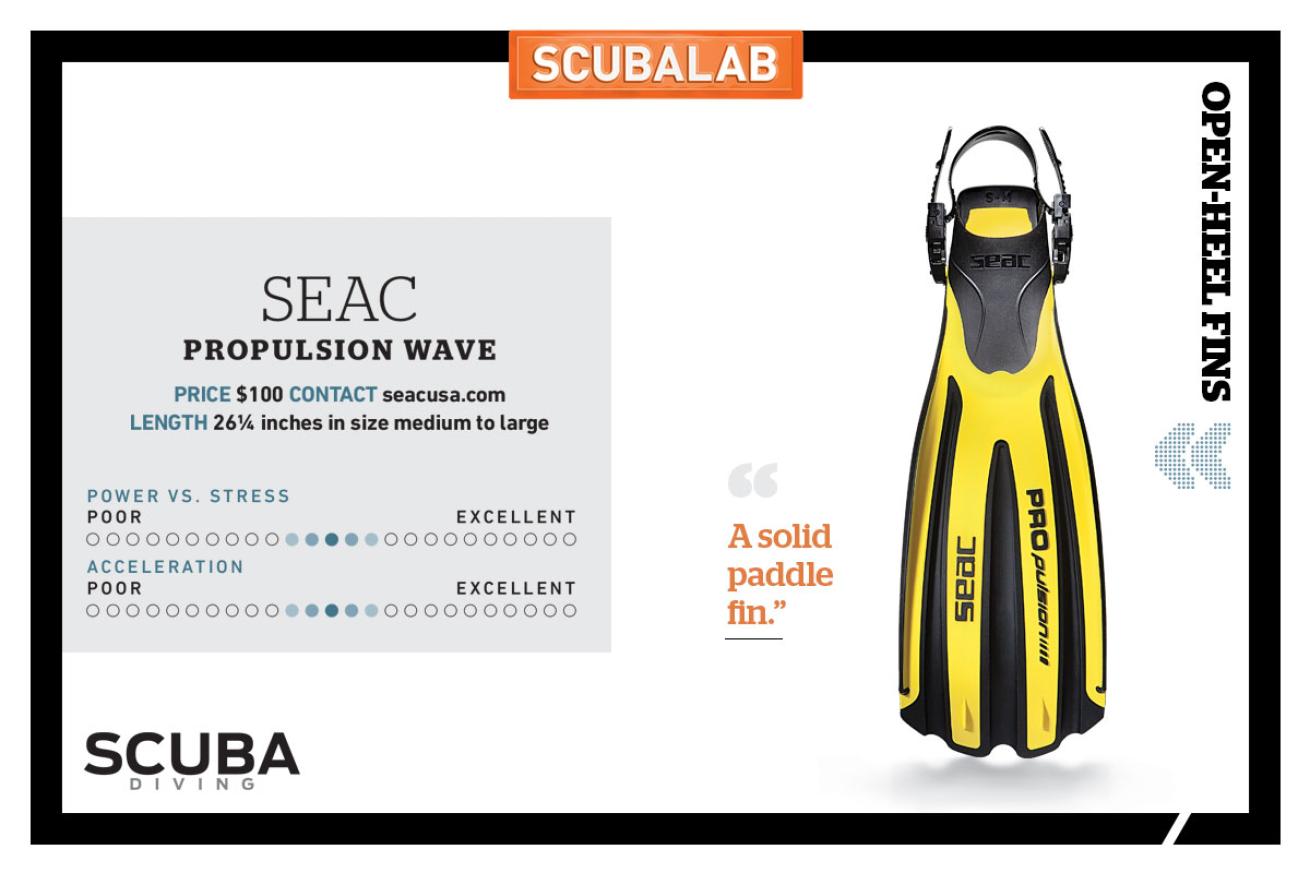
Zach StovallThis SEAC fin is very comfortable and scored well in all of our test categories, though the Propulsion Wave did tend to score higher with scuba divers who prefer softer blades.
The Propulsion Wave has a long blade with three soft, rubbery channel pockets designed to channel water and redirect thrust. Its final scores were notable in that it was the only fin in our test to average a “good” rating in every one of the dozen evaluation categories. But of course those final scores were averages of the individual scores, where divers split along partisan lines of flexible versus stiff blades. Those who prefer long, supple fins rated the Propulsion very good, while those who like more rigid kickers said it was just fair. All divers agreed on the comfort of the Propulsion’s foot pocket, which has a firm, stable base and soft, well-shaped contact areas.
Price: $100 | Contact: seacusa.com
Scubapro Seawing Nova II
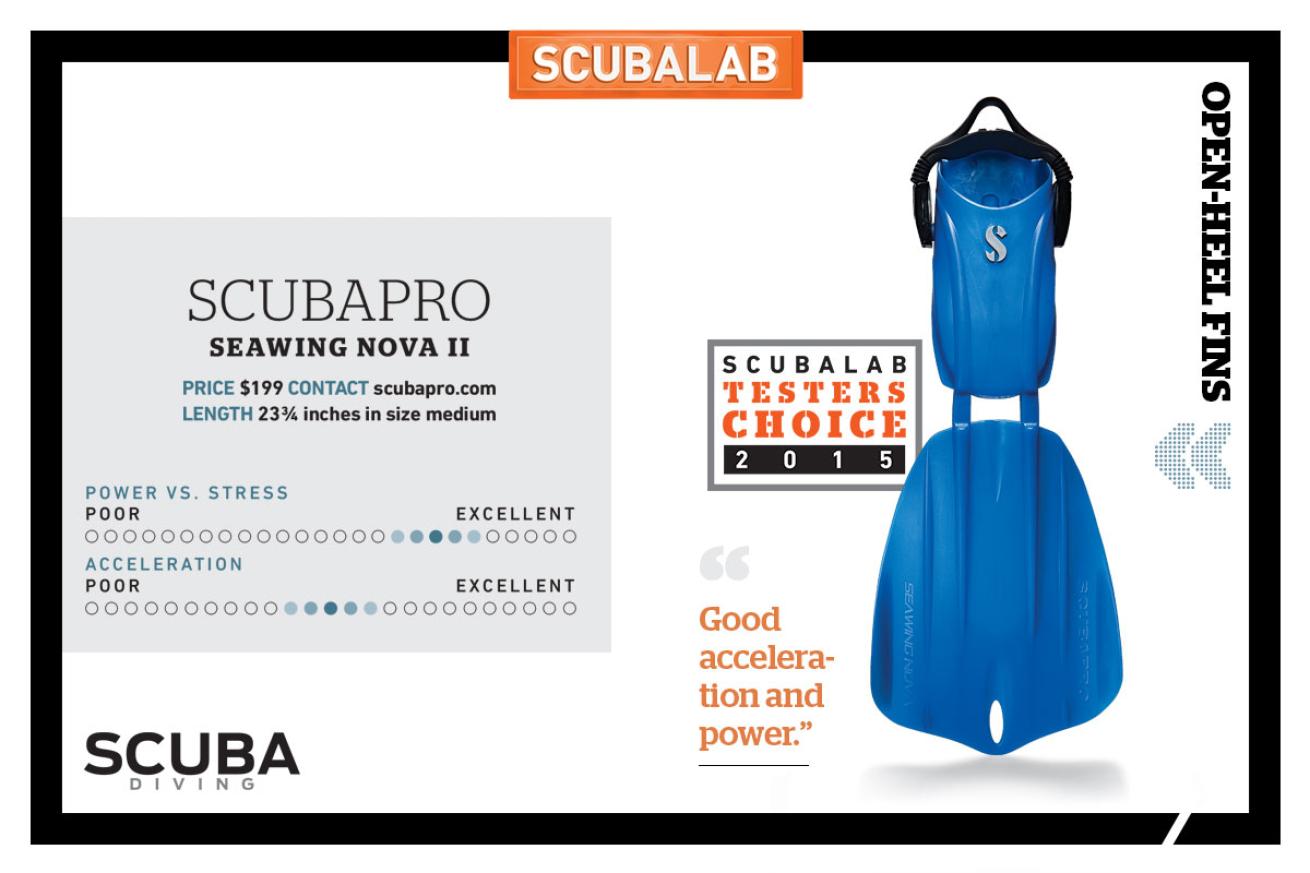
Zach StovallThe Seawing Nova II was our Testers Choice for open-heel fins. Scubapro's latest version of the fin scored high for fit and comfort, power vs stress, and flutter kick.
The original Nova was our Testers Choice in 2010, and the full-foot Nova repeated the feat in 2013. Beyond the vibrant new colors, there are lots of updates to the fin’s design. These include tapering edges of the blade to improve performance in alternate kicking styles. We also noted that the notches on the bottom of the beam hinges are reshaped, and the tabs between them are more flexible, possibly to prevent breakage (a complaint we have heard, but haven’t experienced in testing or use). Test divers gave the Nova high or tying high scores for fit and comfort, power versus stress, flutter kick, donning and doffing, and multiple selections as favorite fin. The Seawing Nova is our Testers Choice in this category.
Price: $199 | Contact: scubapro.com
Sherwood Scuba Triton
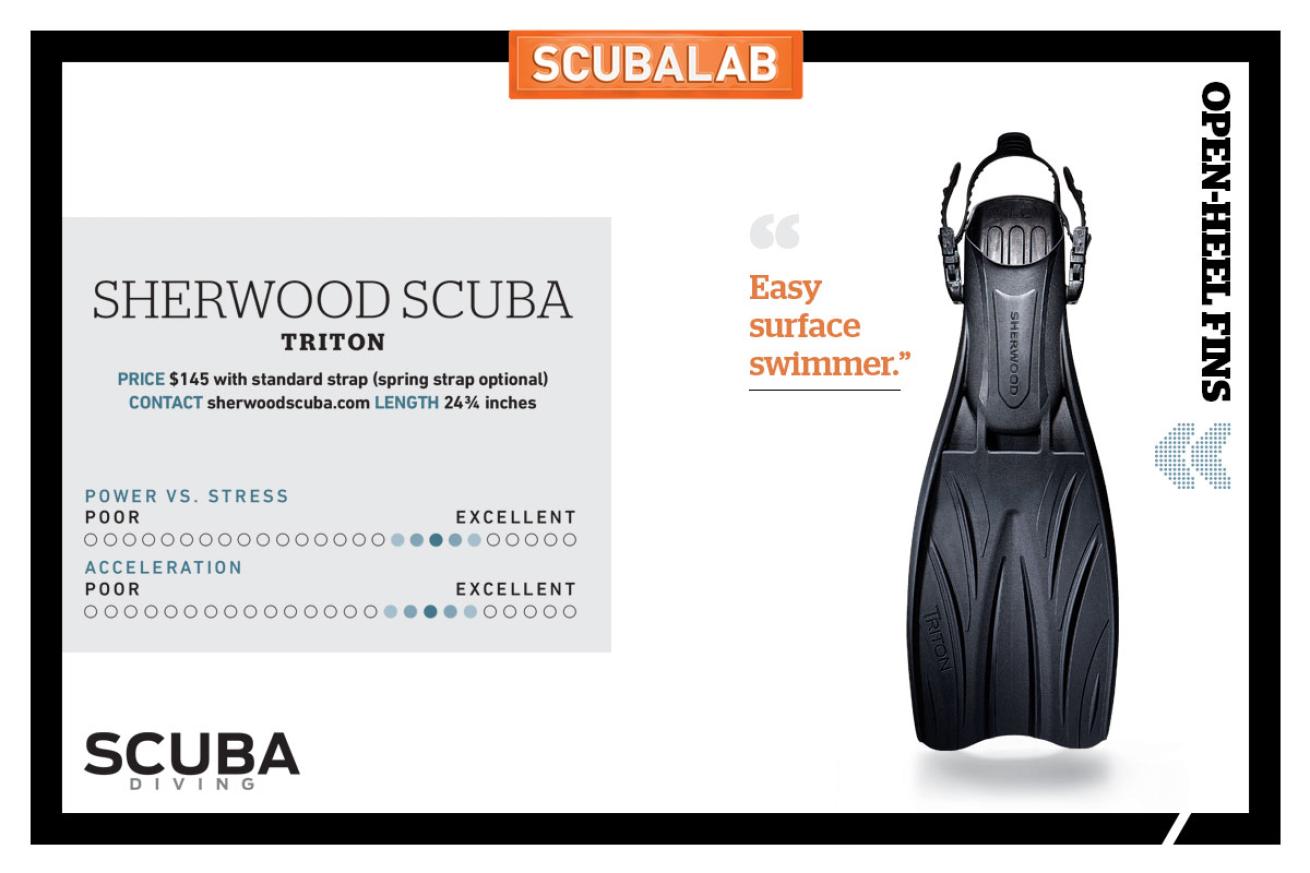
Zach StovallThe Sherwood fin is a light-weight vented fin made of thermoplastic. Not too flexible and not too stiff, the Triton score well for stability, acceleration and surface swimming.
While the Triton was one of four vented fins in our test, a closer look quickly shows that it’s really more a mix of classic and contemporary design. It’s almost 6 inches longer than any of the other vented designs and is made of a thermoplastic that’s quite light, making it nearly a pound per fin lighter than the heaviest model. The material has flex but with a decent snap (the Triton was one of the few fins that wasn’t rapped by any testers as too flexible or too stiff). The Triton finished our test with one of the top combined scores, tied the highest scores for stability and acceleration, was rated best for surface swimming (thanks to its light weight), and multiple divers put it on their lists of top-three fins of the test.
Price: $145 with standard strap | Contact: sherwoodscuba.com
TUSA Solla
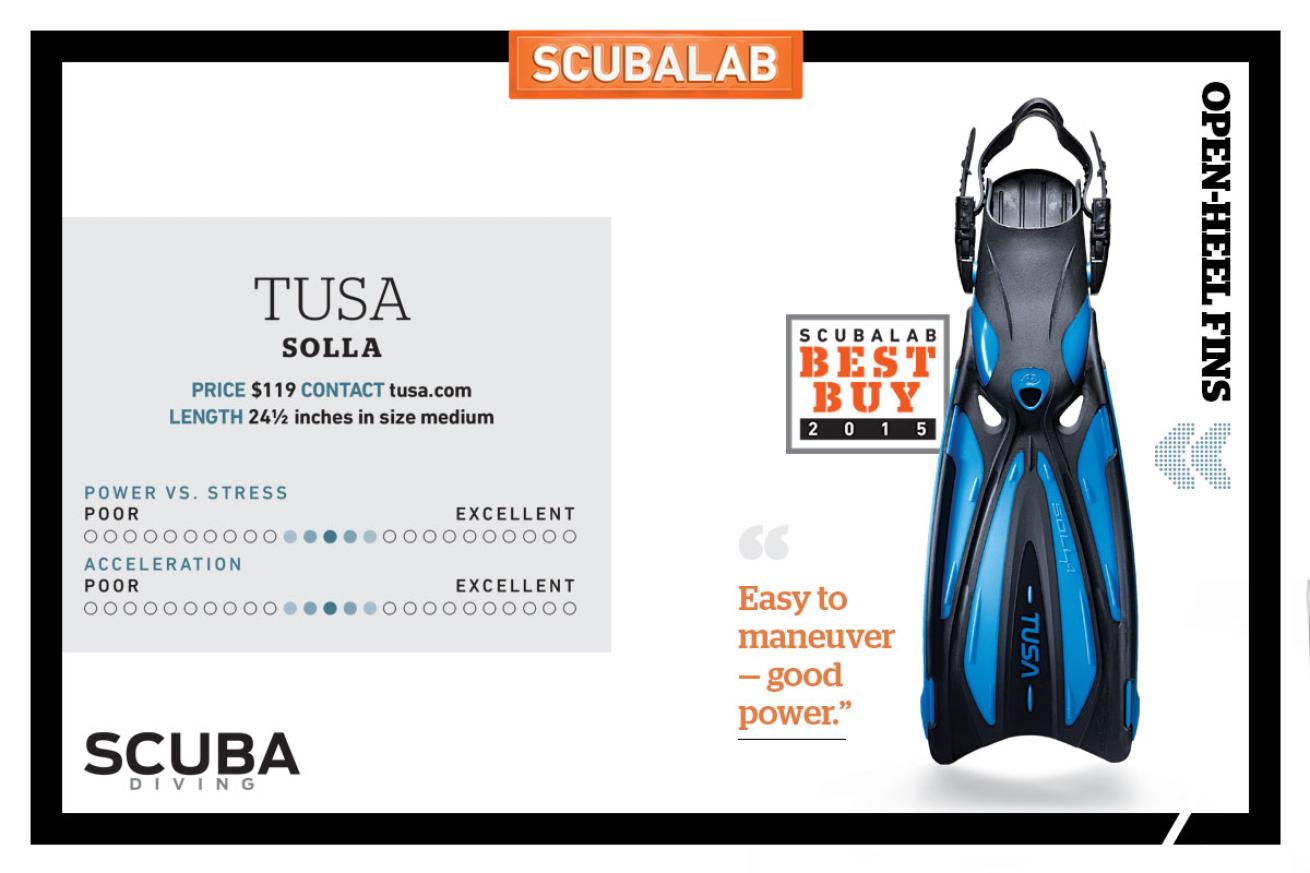
Zach StovallThis TUSA fin provided good thrust without tiring the legs and was highly maneuverable. The capable Solla fin is our Best Buy.
The Solla is made of a thermoplastic elastomer with a mix of hard and soft materials in the blade, the foot pocket and the side rails. The very noticeable stiff-to-flexible gradient in the blade gave the Solla good drive without taxing leg muscles. Most divers also liked the anatomic heel strap, which has an arched section in the middle (and a generous finger slot that earned very good scores for donning and doffing), although a couple of divers with thin boots found the strap design a little tight on their heels. The Solla’s modest size also made it quite maneuverable. A very capable open-heel fin that does everything well — and at a friendly price — the TUSA Solla is our Best Buy.
Price: $119 | Contact: tusa.com
XS Scuba Turtle
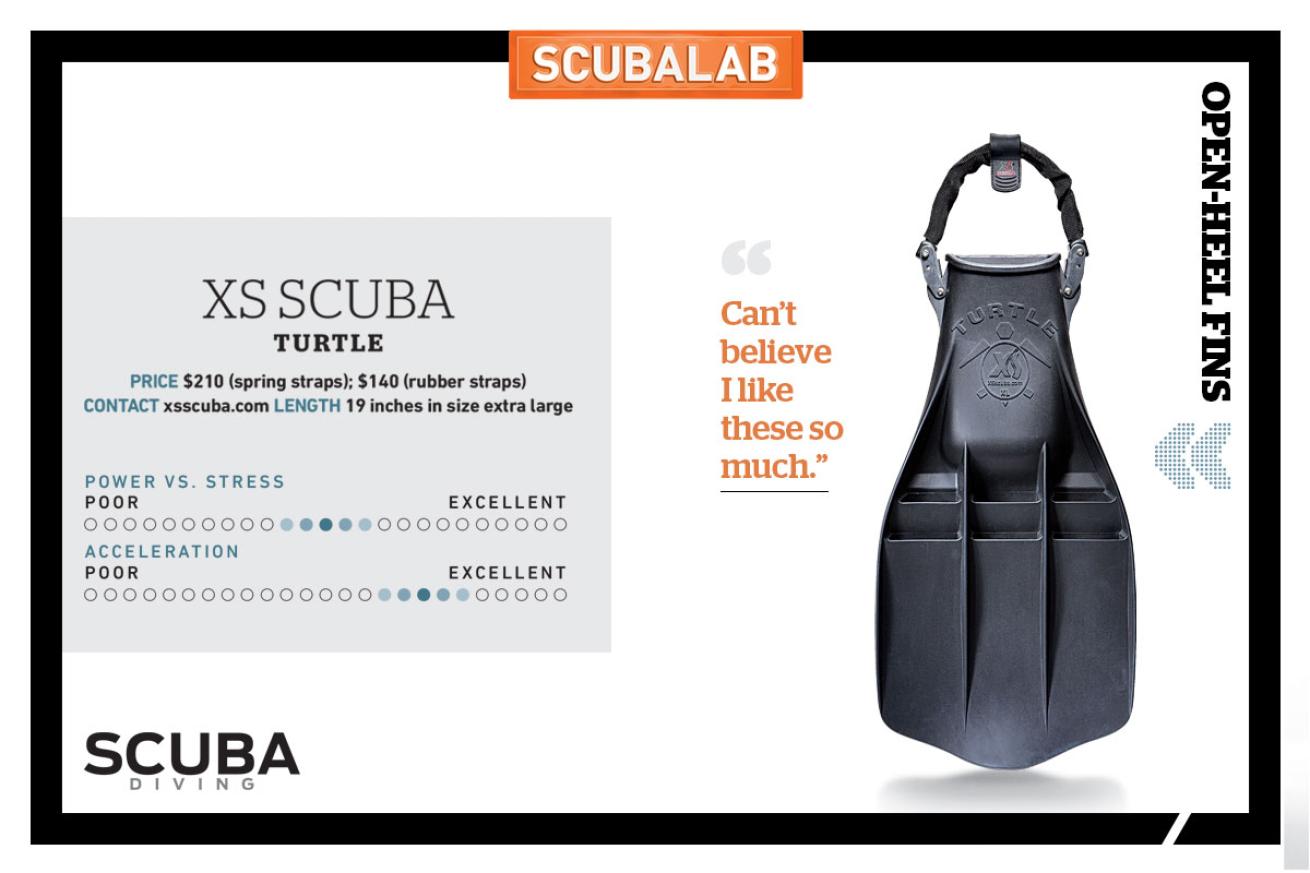
Zach StovallThe Turtle may look old-fashioned, but the XS Scuba fin earned high marks — especially for flutter and dolphin kick.
We tried — unsuccessfully — to resist a tortoise versus hare reference here. But the venerable Turtle (albeit with upgrades) surprised us with its performance. Call the Turtle old-fashioned, but it earned a tie for top overall score. It was the only fin to get top scores for two kicking styles (flutter and dolphin), and it tied the top score for acceleration. It was hurt by odd sizing, which kept a third of our test divers from using it (the sizes run from XL, which is like large, to 3XL, which will fit Sasquatch’s drysuit boots). The new spring strap is secure and has a solid finger grip that won’t get tangled but isn’t that easy to grasp. The moral of this story is, don’t laugh at Grandpa’s fins until you try them.
Price: $210 (with spring straps; $140 (with rubber straps) | Contact: xsscuba.com
Insights From The ScubaLab Fin Test
Barefoot Comfort
No matter how great its design, you won’t really like your non-adjustable full-foot fins unless the fit is nearly perfect. So take the time to try on every available size to find one that’s just right for you.
Old is the New New
Nearly half of the fins we tested this year have strong design or material elements of classic fins — some going back decades. Our testing suggested that most divers are more concerned about performance (and some of those classic designs and materials performed very well) than whether a fin is old-fashioned or “funny” looking. In any case, as one diver noted, when they’re on your own feet, you don’t really see what they look like anyway.
What Kind of Fin?
There used to be scuba fins that we described as “full-foot” that slipped onto your bare feet with a stretch fit and had no adjustment, and fins we called “open-heel” that went over dive boots and had adjustable straps. You’ll notice our test crop this year included a pair of adjustable fins for bare feet, while half of the open-heel fins we tested had nonadjustable spring or bungee straps. While these newfangled design elements complicated our open-heel and full-foot category groupings, we view the new designs as a good thing — the in-water result has been less fuss and better comfort.
Vents and Channels
Two ways engineers boost efficiency in fins are with angled vents, something like louvers, and with channels of soft material in the blade to trap scoops of water — both designed to redirect water for increased thrust.
Splitsville for Splits
A few years ago manufacturers were rushing to meet the demand for split fins, but it seems the trend has peaked; we haven’t had a new split fin submitted for ScubaLab testing since 2012. On the other hand, we still see plenty of splits when we’re diving — and know divers who swear by theirs — and many manufacturers still offer them in their lineups.
Q: What makes a fin a favorite?
A: Fin tests are subjective simply because divers have such a broad range of swimming styles and physical characteristics. So it’s no surprise that divers have very different ideas about what constitutes an “ideal” fin. Still, comparing divers’ test scores to the fins they chose as favorites revealed what they valued most: power versus stress (more effort equals more thrust); fit and comfort; and stability.— Roger Roy, ScubaLab Director
How to Care for Your Scuba Fins
Now that you’ve found your sole-mates, keep them in tip-top condition with these tips.
Stash them out of the sun when they’re not being used. Exposure to heat and sunlight can cause premature cracking and discoloration, and can also weaken the bonds between composite materials.
Keep blades, buckle assemblies and straps clean.
Always store fins flat, otherwise you could end up with a permanent bend or crease in the blade, which could hinder its in-water performance.
New fins usually come with foot-pocket inserts — make sure you don’t throw them away. Storing your fins with the inserts in place will help maintain the shape of the fin’s foot pocket when you’re not diving — kind of like using a shoe tree for your street shoes.
Looking for more ScubaLab testing? Check out more of our gear reviews:
- SCUBALAB 2015: Dive Knife Review
- SCUBALAB 2015: Travel Gear Review
- SCUBALAB 2014: Gear of the Year
- SCUBALAB 2014: Dive Bag Review
- SCUBALAB 2014: Regulator Review
- SCUBALAB 2014: BC Review
- SCUBALAB 2014: Dive Lights Review
- SCUBALAB 2014: Wetsuit Review
- SCUBALAB 2013: Fins Review
- SCUBALAB 2013: Mask Review
- SCUBALAB 2013: Regulator Review
---
No Two Blades Alike
A glance at these fins shows the diversity of designs from engineers all trying to solve the same problem: how to efficiently convert the back-and- forth motion of our legs into forward thrust in the water.
---
SEARCHING FOR GEAR? START HERE:

